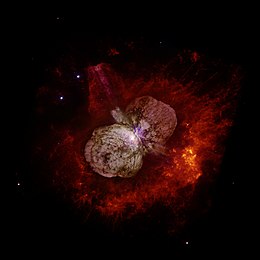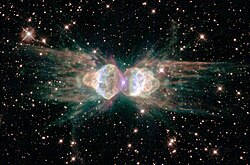Official Setting information is in green. Extended Universe information is in blue.
6,500 ly
◉Elysium (G-PN 88)
Distance from Earth: at least 6,500 ly; near: under investigation
Allegiance: abandoned Emigrant planet temporarily taken over by anti-Unified Government Zentrādi
Star: under investigation
The Digital Mission Macross VF-X story takes place here.
▲ Top ▶ Locations Index
7,200 ly
Globular Cluster M4
 Distance from Earth: 7,200 ly; near: under investigation
Location: under investigation
Distance from Earth: 7,200 ly; near: under investigation
Location: under investigation
a rather loosely concentrated cluster of stars that measures 75 ly across.
from Earth, appears about the same size as the Moon in the sky.
At least 43 variable stars have been observed within M4.
▲ Top ▶ Locations Index
7,500 ly
0A. Eta Carinae (η Car A)
Size: 120–200 solar masses
Type: similar to a luminous blue variable
Distance from Earth: around 7,500 ly
Orbital period: under investigation
Near: under investigation
Location: inside the Eta Carina Nebula.
It has lost at least 30 solar masses already in the Great Eruption (1837–1855), and is expected to explode as a supernova in the astronomically near future.
0B. Eta Carinae (η Car B)
Size: 30–80 solar masses
Type: probably of spectral class O
Distance from η Car A: 15.4 AU
Orbital period: 5.54 years
Eta Carina Nebula
 The system is surrounded by a large, bright nebula, known as the Eta Carinae Nebula, the Keyhole Nebula, or NGC 3372.
The stars is heavily obscured by the Homunculus Nebula, material ejected from the primary during the Great Eruption.
as of July 2005, Eta Car is the 5th most luminous star yet discovered, and still the most massive.
Mylene Flare Jiinasu, the 7th child of Maximilian and Miria Farina Jiinasu, born onboard the space carrier Red Moon in flight near the Nebula, on 2031.02.02.
The system is surrounded by a large, bright nebula, known as the Eta Carinae Nebula, the Keyhole Nebula, or NGC 3372.
The stars is heavily obscured by the Homunculus Nebula, material ejected from the primary during the Great Eruption.
as of July 2005, Eta Car is the 5th most luminous star yet discovered, and still the most massive.
Mylene Flare Jiinasu, the 7th child of Maximilian and Miria Farina Jiinasu, born onboard the space carrier Red Moon in flight near the Nebula, on 2031.02.02.
▲ Top ▶ Locations Index
8,000 ly
0. Helix Nebula (NGC 7293)
Size: 1.0 ly radius
Type: planetary nebula
Distance from Earth: ~8,000 ly
Orbital period: under investigation
Near: under investigation
Location: under investigation
radially expanding at a rate of about 50 km/s
 A young bipolar planetary nebula that is composed of a bright core, and four distinct high-velocity outflows that have been named lobes, columns, rays, and chakram. These nebulosities are described as: two spherical bipolar lobes, two outer large filamentary hour-glass shaped columns, two cone shaped rays, and a planar radially expanding, elliptically shaped chakram.
Mz 3 is a complex system composed of three nested pairs of bipolar lobes and an equatorial ellipse. Its lobes all share the same axis of symmetry but each have very different morphologies and opening angles. It is an unusual planetary nebula in that it is believed to contain a symbiotic binary at its center. One study suggests that the dense nebular gas at its center may have originated from a source different from that of its extended lobes. The working model to explain this hypothesizes that this planetary nebula is composed of a giant companion that caused a central dense gas region to form, and a white dwarf that provides ionizing photons for the planetary nebula.
Mz 3 has no trace of molecular hydrogen emission. The lack of H2 emissions from Mz 3 is unusual given the strong correlation between such emissions and bipolar structures in planetary nebula. Laser light emissions have been detected from the nebula—specifically, hydrogen recombination line laser emissions. This confirms the presence of a white dwarf with a binary companion at the heart of the nebula.
Of the morphological features of Mz 3, one of the most unusual and odd is the chakram, a faint, large, limb brightened ellipse that appears to have its center on the planetary nebula's nucleus. While the plane of the ellipse is near the other feature's shared reflection symmetry plane, it is definitely offset.
A young bipolar planetary nebula that is composed of a bright core, and four distinct high-velocity outflows that have been named lobes, columns, rays, and chakram. These nebulosities are described as: two spherical bipolar lobes, two outer large filamentary hour-glass shaped columns, two cone shaped rays, and a planar radially expanding, elliptically shaped chakram.
Mz 3 is a complex system composed of three nested pairs of bipolar lobes and an equatorial ellipse. Its lobes all share the same axis of symmetry but each have very different morphologies and opening angles. It is an unusual planetary nebula in that it is believed to contain a symbiotic binary at its center. One study suggests that the dense nebular gas at its center may have originated from a source different from that of its extended lobes. The working model to explain this hypothesizes that this planetary nebula is composed of a giant companion that caused a central dense gas region to form, and a white dwarf that provides ionizing photons for the planetary nebula.
Mz 3 has no trace of molecular hydrogen emission. The lack of H2 emissions from Mz 3 is unusual given the strong correlation between such emissions and bipolar structures in planetary nebula. Laser light emissions have been detected from the nebula—specifically, hydrogen recombination line laser emissions. This confirms the presence of a white dwarf with a binary companion at the heart of the nebula.
Of the morphological features of Mz 3, one of the most unusual and odd is the chakram, a faint, large, limb brightened ellipse that appears to have its center on the planetary nebula's nucleus. While the plane of the ellipse is near the other feature's shared reflection symmetry plane, it is definitely offset.
▲ Top ▶ Locations Index
12,400 ly
0. PSR B1620-26 A
Size: 1.35 solar masses
Type: pulsar, neutron star
 Distance from Earth: 12,400 ly
Orbital period: under investigation
Near: under investigation
Location: under investigation
A binary star system located in the globular cluster of Messier 4 in the constellation of Scorpius (circled in green). The system is composed of a pulsar (PSR B1620-26 A), and a white dwarf star (WD B1620-26 or PSR B1620-26 B). The system is also confirmed to have an exoplanet orbiting the two stars.
The double system (triple including the substellar companion) is just outside the core of the globular cluster. The age of the cluster has been estimated to be about 12.2 billion years. Hence this is the age estimate for the birth of the planet, and two stars.
PSR B1620-26, the primary, spins at 100 revolutions per second, and has a likely radius of around 20 km.
Distance from Earth: 12,400 ly
Orbital period: under investigation
Near: under investigation
Location: under investigation
A binary star system located in the globular cluster of Messier 4 in the constellation of Scorpius (circled in green). The system is composed of a pulsar (PSR B1620-26 A), and a white dwarf star (WD B1620-26 or PSR B1620-26 B). The system is also confirmed to have an exoplanet orbiting the two stars.
The double system (triple including the substellar companion) is just outside the core of the globular cluster. The age of the cluster has been estimated to be about 12.2 billion years. Hence this is the age estimate for the birth of the planet, and two stars.
PSR B1620-26, the primary, spins at 100 revolutions per second, and has a likely radius of around 20 km.
1. WD B1620-26 (PSR B1620-26 B)
Size: 0.34 solar masses
Type: white dwarf
Distance from PSR B1620-26 A: 1 AU
Orbital period: about once every 6 months
The secondary has a likely radius of around 0.01 solar radii.
PSR B1620-26c "Methuselah"
Size: 2.63 Jupiter masses
Type: gas giant
the first circumbinary planet ever confirmed.
the first planet found in a globular cluster.
Rotation: under investigation
Orbital period: about 100 years at 23 AU
Atmosphere: under investigation
Water: under investigation

Orbit
under investigation
The planet is in a circumbinary orbit around the two stars of PSR B1620-26 (which are a pulsar and a white dwarf). The planet is one of the oldest known extrasolar planets, believed to be about 12.7 billion years old, nearly three times as old as Earth.
The origin of this pulsar planet is still uncertain, but it probably did not form where it is found today. Because of the decreased gravitational force when the core of star collapses to a neutron star and ejects most of its mass in a supernova explosion, it is unlikely that a planet could remain in orbit after such an event. It is more likely that the planet formed in orbit around the star that has now evolved into the white dwarf, and that the star and planet were only later captured into orbit around the neutron star. Stellar encounters are not very common in the disk of the Milky Way, where the Sun is, but in the dense core of globular clusters they occur frequently. At some point during the 10 billion years, the neutron star is thought to have encountered and captured the host star of the planet into a tight orbit, probably losing a previous companion star in the process.
The long-term prospects for PSR B1620-26 b are poor. The triple system is slowly drifting down into the core of the cluster, where the density of stars is very high. In a billion years or so, the triple will probably have another close encounter with a nearby star. The most common outcome of such encounters is that the lightest companion is ejected from the multiple star system. If this happens, PSR B1620-26 b will most likely be ejected completely from M4, and will spend the rest of its existence wandering alone in interstellar space as an interstellar planet.
▲ Top ▶ Locations Index
 MAIN INDEX
MAIN INDEX MAIN INDEX
MAIN INDEX



